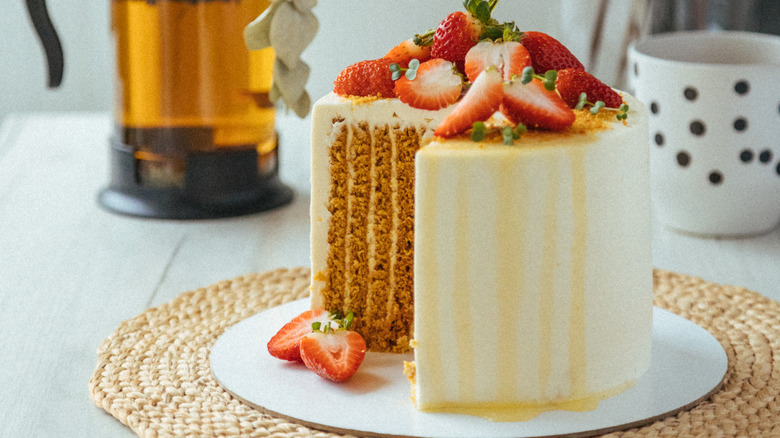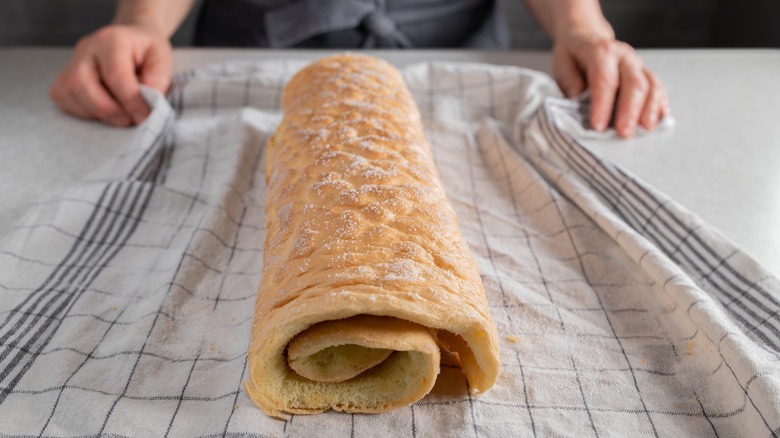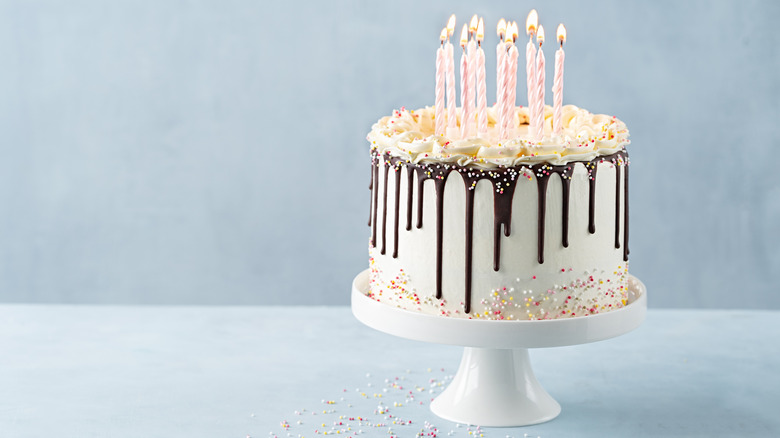What Is Vertical Layer Cake?
A high point for any of life's milestones is cutting into a celebratory cake, whether it's a baby destroying a smash cake for their first birthday or a bride and groom lovingly dabbing one another with frosting at a wedding. Yet, while traditions hold strong, today's bakers are also shaking things up with creative takes on the party staple.
In recent years, social media has been abuzz with candy-filled surprise cakes, which gush sprinkles when sliced open, and hyper-realistic illusion cakes. The latest trend circulating online and even making an appearance as a "Great British Baking Show" cake week challenge is the vertical layer cake.
A slice of the pastry reveals thick lines similar to zebra stripes, rather than the neat horizontal layered cakes most of us are used to. The trick to making one a vertical layer treat is to bake a single thin cake on a jelly roll pan, frost the cooled spongey result, and then roll it starting at one end, similar to a jelly or Swiss roll. Savvy eaters will notice that, in addition to the appealing look, the design also gifts recipients with more layers of frosting and fluffy pastry to enjoy.
Tricks to making a vertical layer cake
Rolling a single layer of cake into a shape sounds deceptively easy when compared to the usual assembly methods. However, there are a few smart tweaks you can make to ensure smooth sailing every time. To achieve a lightweight cake, you'll need to take a page from Swiss rolls and use a recipe for a sponge cake rather than a heavier butter cake. These desserts rely on foam from whipped egg whites for airy texture.
Just remember to keep a close eye on the baking process as it can quickly go from done to dry. To avoid cracks in the cake, once it's out of the oven, remove from the pan and place on a clean towel or parchment paper. Dust both your work surface and the cake with powdered sugar, then carefully roll the warm pastry into the shape before cooling.
There's another secret to assembling a wide cake like a vertical layered variety. Once you've frosted the dessert, slice the entire pastry in half or thirds to create long ribbons. Then roll one strip into a round, attach it to the next strip, and repeat. This creates a single wide cylinder with many rings and, thus, those desirable stripes.
Winning flavors and decorations for your cake
This technique for making a vertical layer cake delivers a lightweight spongey texture and a generous serving of filling. Though you can stick with the classic vanilla base and chocolate buttercream frosting, the cake also works well with a refreshingly tart citrus or berry whipped cream. For even more of a surprise, try layering a chocolate spread or jam onto the sponge before adding the creamy topping.
Although it's what's on the inside that counts, bakers may want to try something new on the outside of the striped dessert, too. Use a different frosting like tangy cream cheese or rich Swiss buttercream for the exterior of the cake. Or, frost with meringue to create a s'mores-inspired cake, which would pair nicely with a chocolate sponge base.
And finally, consider mimicking the decorative interior on the outside of the cake; complement the vertical layers by adding a drip frosting to the sides. To do so, once the cake is frosted and just about complete, gently spoon a mixture of milk and melted chocolate over the exterior of the cake. Allow the ganache drips to flow and harden to perfect your celebratory creation.



